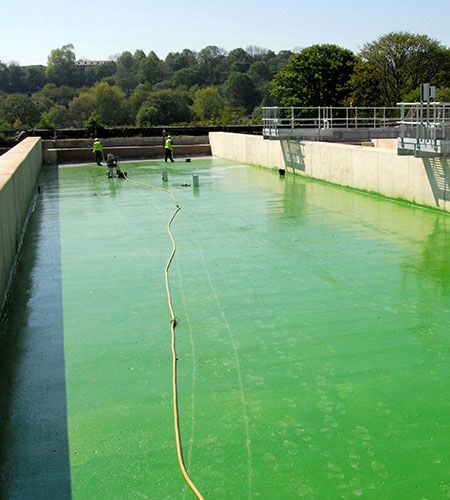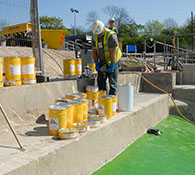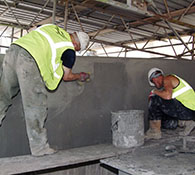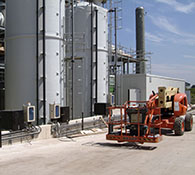Sewage & Waste Water Treatment Plants
Protective Coatings & Containment Bund Linings for Sewage & Waste Water Treatment Plants
Sewage and Waste Water
Waste water comprises a mixture of domestic sewage (waste from household toilets, sinks, showers and washing machines), industrial effluent, occasional run-off of surface water and ground water which has infiltrated into the sewers. As such the collection and treatment infrastructure must all be made watertight and adequately protected against attack from the varying concentrations of the sewage and other chemicals involved.
The resultant waste water is, perhaps surprisingly, overall on average at the time it enters the waste water treatment plants, still around 99.99% water, with a large, but relatively small amount of dissolved or suspended inorganic and organic solid matter.

At the more than 9000 Sewage & Waste Water Treatment plants in the UK, this waste water undergoes multi-stage treatment processes to clean and purify it before discharge back into the environment, or for reuse in industry, or even as drinking water directly. These treatments can be summarised as follows:
Preliminary Treatment of Sewage and Waste Water
Sewage undergoes preliminary treatment to make it suitable for the main treatment processes. This includes screening and removing grit, and possibly oils and grease. The first stage of the treatment process is simple screening, which basically uses different sized screens to remove the larger solid materials such as wood, leaves, paper and plastics that could damage machinery or block pipe systems further along the water treatment process. Screens consist of vertical bars spaced close together or perforated plates that are cleaned by rakes or water jets. This is followed by the removal of smaller denser particles such as sand or silt, which are abrasive to the treatment structures and equipment, by flowing the waste water slowly through gravel or grit filtration tanks, plus in some treatment works the waste water is also passed through an Oil Separator, a structure to collect and remove oils and grease.
Primary Treatment of Sewage and Waste Water
Following the preliminary screening treatment, the wastewater is passed into large round or rectangular Primary Sedimentation Tanks where much of the organic solids, and other fine particles that still remain suspended in the water, settle out to the bottom to form sludge. This sludge is collected from the bottom of these tanks by large metal or rubber Scraper Blades that pass it to a submerged outlet in the centre, from where it is pumped to storage tanks for subsequent treatment and may well then be used as soil conditioner or fertilisers. The abrasion from this sludge scraping action can also be damaging to the concrete structure and adequate protection against this should be applied on new structures to prevent expensive future repairs and possible groundwater contamination.
Preliminary and Primary treatment processes remove about 60–70% of suspended solids and so the liquid waste water leaving these tanks still contains very fine solids and dissolved materials, so additional or Secondary treatment is usually required. The liquid part of the settled liquid in the primary sedimentation tanks flows over weirs and into tanks for this to take place.
Secondary Treatment of Sewage and Waste Water
This phase is predominantly achieved by biological processes, in which micro-organisms consume and breakdown dissolved organic materials and oxidise dissolved compounds to decompose them, a process similar to that taking place naturally but at a slower rate in rivers, the soil, and even in the filter beds in clean water treatment works. These processes are speeded up during the secondary treatment of sewage and waste water by increasing the amount of oxygen available, which can be done by two possible methods:
The Filter Bed Method:- Filter beds are the traditional method of safely handling and breaking down the majority of domestic sewage and waste water in the UK. They are efficient and effective, requiring very little supervision and once properly designed and built, the structures are not normally severely exposed to attack – they generally just need to be made reliably watertight and protected against freeze-thaw damage above the waterline. However these large filter beds also require a lot of space and therefore take up a lot of land and as a result, alternative processing solutions are increasingly being used when existing filter beds are replaced at the end of their life – Many in the UK are 50 years old or even considerably more.
In these filter bed systems the waste water liquid is sprayed slowly over beds of stone, gravel, coke or even now plastic chips, which provide a very large surface area for oxidation, and the micro-organisms (mainly bacteria) living within the filter beds can easily access and break down the suspended organic matter and dissolved organic compounds. The liquid that collects at the base of these filter beds still contains some waste products, including those form the filter organisms themselves, and so these are separated out again from the liquid effluent when it is transferred into the Secondary Sedimentation Tanks, producing yet more sludge.
This final stage in the filter bed method is also a biological process which breaks down the majority of any remaining dissolved and suspended organic solids by using the same naturally occurring micro-organisms. It is actually the same as the alternative to the filter bed method of purification, but when used on its own, this process is carried out with even higher levels of oxygenation and agitation, to accelerate the growth and activity of these micro-organisms. This part of the secondary sewage treatment process, or this as a standalone process, is called the ‘Activated Sludge Process’.
The Activated Sludge Process: This involves ‘Sludge’ containing bacteria and other organisms being mixed with the waste water liquid in an ‘Aeration Tank’, and then the whole mixture is agitated by large mixing paddles and has compressed air blown and bubbled through it, in order to keep the environment well oxygenated and to provide excess oxygen. This promotes oxidation of dissolved organic compounds and the rapid growth of the micro-organisms, which means that this “active biomass” with the excess oxygen available, quickly consumes and breaks down any remaining organic pollutants and nutrients in the wastewater.
IFAS (Integrated Fixed-film Activated Sludge) is a treatment process now used to reduce nitrogen in existing wastewater treatment plants. IFAS involves introducing small free floating plastic cylinders into the aeration tanks where they provide a large surface area to which biological growths attach, thereby increasing the treatment capacity of the plant.
This biological process can also be accelerated by additional heating, particularly in cold zones or winter periods. Normally this ‘active sludge process’ in modern facilities is designed to last about 10 hours, after which the mixture flows to the Secondary Sedimentation Tanks, also now known as ‘Clarifiers’, which again are where the micro-organisms and their food and waste products settle out from the effluent under gravity to the bottom of the tank and are concentrated as sludge for removal. It is some of this sludge that is recycled to the inlet of the Aeration Tanks to maintain and continue generation of the biomass, hence the name – ‘The Activated Sludge Process’.
After this secondary treatment most authorities target around a 90% reduction in the Biological Oxygen Demand (BOD), which is used as a qualitative assessment of the water from the effluent, to confirm that it is sufficiently purified to be discharged to a river, lake or the sea, where immediate large scale dilution also takes place.
As a result of the increased movement and activity in this process the concrete structures and steel equipment is more aggressively exposed and therefore is best protected from new with waterproof, abrasion and reasonably chemical resistant coatings and linings, NCC can advise on the most suitable products and systems for the protection of your new treatment facilities, or the repair and protection of deteriorated existing structures.
So following the primary and secondary treatment processes the clarified waste water is discharged, or sent for its final disinfection or ‘Tertiary Treatment’ if it is to be used for other purposes, or if the water quality and level of purification must be even higher in sensitive environments or for use as drinking water.




Tertiary Treatment of Sewage and Waste Water
Tertiary treatments of sewage and waste water is normally designed according to the quality of the water after primary and secondary treatment at the specific waste water treatment plant, plus the environment it is to be discharged into, or the usage for which the treated water is intended.
The standard is chlorine disinfection to kill any remaining bacteria, or where discharges are made to bathing waters or shellfish growing areas for example, then disinfection by ultra violet light, ozone or the removal of bacteria and viruses by fine membranes is used.
Dissolved Air Flotation Filtration (DAFF), is a modern treatment process that is carried out to produce a much higher standard of treated waste water that is suitable for reuse as drinking water and other clean water purposes.
Sewage Sludge Treatment
The ‘Sludge’ collected during the treatment process also contains a large amount of biodegradable material making it amenable to treatment by a different set of micro-organisms, called anaerobic bacteria, which means that they do not need oxygen for growth and breakdown of this material.
Anaerobic digestion is a series of processes in which microorganisms break down the biodegradable material in the absence of oxygen, which takes place in special fully enclosed Digester Tanks that are heated to 35°C, where these anaerobic micro-organisms thrive without any oxygen. It is used for industrial or domestic purposes to manage waste and/or to release energy.
One of the main by-products of these biological processes is methane, which is another reason why a closed tank is used and the valuable gas is collected. The methane can then be used to heat the digesting sludge to maintain the efficiency of the process, or used elsewhere within the sewage treatment works to provide heating, or to generate electricity and power the equipment, or it can even be supplied or sold to adjacent facilities.
Once the micro-organisms have done their work, water is removed from the digested sludge through mechanical means such as centrifuging, or by natural solar evaporation in lagoons. The liquid remaining at the end of the process is usually pumped back into the system at the aeration tanks.
The stable, solid material remaining or the bio-solids as it is called commercially, looks feels and smells like damp earth and makes good soil conditioners and fertilisers that are used in agriculture, or bagged and sold through Garden Centres.
Additional Sewage and Waste Sludge Treatments
Aerobic digestion is used to pasteurise the sludge. When air is pumped into the digester bacterial activity generates heat that kills off pathogens and reduces organic content.
Dewatering of the sludge reduces its volume for transport and the processes that are used for this include thickening under gravity in taller tanks, or mechanical compaction and dewatering to produce ‘sludge cakes’ – as normally prepared for use as fuel – see below. Mechanical dewatering systems normally require the addition of chemicals to the sludge to flocculate the solid particles and therefore make settlement and separation of the solids easier.
Lime stabilisation involves mixing the dewatered sludge cakes with lime. The lime reacts with the residual water in the sludge and this chemical reaction produces heat – the increasing temperature and pH kill any residual pathogens and the added lime may also be useful for farmers, when the finished material is used as a safe and soil conditioning fertiliser.
Thermal drying can be used on both dewatered digested or untreated sludge. This is a simple heating process that drives off the water and kills harmful bacteria. The reduced weight, lower volume material is then also useful for agricultural and horticultural applications.
Incineration can be used for dewatered or thermally dried sludge cakes. The heat produced is generally used to generate electricity via steam turbines, which is used to power the waste water treatment works, or can sold into the National Grid.. The sludge cakes can also be sold externally and used in power stations or cement works for example, as a substitute for fossil fuel.
Treated sewage sludge (usually known as bio-solids) is therefore a valuable product of waste water treatment works. It contains organic material and nutrients that are important for agriculture or land reclamation. The organic material is a carbon source and can also be used as a fuel to produce energy.
Materials and Products in Contact with Sewage & Waste Water
There are some important areas of all reinforced concrete decked car parks that will always require ‘Special Care & Consideration’ and usually they should receive additional or alternative treatments in both new construction and refurbishment works. These include:
Car Park Ramp Waterproofing Systems:
The no regulations or standards for products used in the protection of concrete and steel structures in contact with sewage and waste water.
All of NCC’s specialists are fully aware of all of the product requirements for use in contact with sewage & waste water from drainage systems and containment tanks to oil separators and the sewage and waste water treatment plants and all of the specialised structures within them. For FREE Expert advice on the selection and use of the most appropriate products and systems for use to protect, or repair and protect your Sewage & Waste Water storage and treatment facilities, please call any of our offices and one of our specialists will be happy to assist you.
